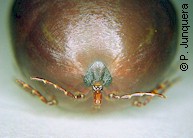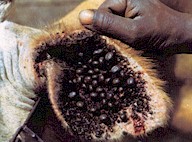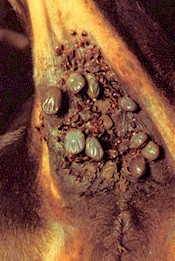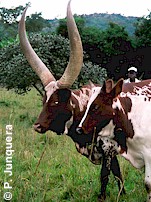Rhipicephalus is a genus of hard ticks native to Africa but several species were introduced in Europe and America during the last centuries. There are about 60 species of this genus.
There are about 60 species of this genus.
Nowadays ticks of the former genus Boophilus are included in the genus Rhipicephalus. In this site Boophilus ticks are handled separately from the remaining Rhipicephalus species because their particular behavior is decisive for establishing control strategies, and because they are enormously important for the livestock industry in numerous tropical and subtropical regions of the world. Click here to visit the Boophilus page in this site.
The most relevant species for livestock, horses, dogs and cats are:
- Rhipicephalus appendiculatus, brown ear tick; important for livestock; Africa South of Equator
- Rhipicephalus bursa, Southern Europe, Near and Middle East,
- Rhipicephalus evertsii, the red-legged tick; important for livestock; Africa South of Equator
- Rhipicephalus sanguineus, the brown dog tick; important for dogs; worldwide
There are specific articles in this site on ticks in dogs and cats, as well as on ticks in horses.
Biology and life cycle of Rhipicephalus ticks

As all hard ticks, Rhipicephalus ticks are obligate parasites: they cannot survive without feeding blood of their hosts.
Rhipicephalus appendiculatus is a three-host tick that infests mainly cattle and other large ruminants (e.g. buffaloes, antelopes), but also sheep, goats, carnivores and rabbits. It occurs in Africa south of the Equator. It prefers humid woodlands or relatively cool savannas with abundant shrubs that provide shelter from the sun. It does not support arid climates. It is the most damaging Rhipicephalus species in East and Central Africa.
It is a rather large tick, engorged adult females can be larger than 2 cm. Preferential site on cattle are the ears. By heavy infestations it is also found around the eyes, on the neck, on the perineum and elsewhere. Engorged females lay up to 5000 eggs. The life cycle lasts 3 to 9 months. Up to 3 generations a year can follow in regions with two rainy seasons.
Questing larvae can survive up to 10 months in the environment waiting for a host to pass by, nymphs up to 15 months, and adults up to 2 years. For this reason all developmental stages are usually found simultaneously on infested pastures. In parts of South Africa developmental stages show a seasonal distribution: larvae predominate from May to June, nymphs from July to September, and adults from November to March.
Rhipicephalus appendiculatus transmits many microbial diseases of livestock such as various species of Babesia, Anaplasma and Theileria (notably Theileria parva, the agent of East Coast Fever, often fatal for cattle), Ehrlichia (=Cowdria) ruminantium, (the agent of heartwater), Trypanosoma congolense and brucei (agents of sleeping sickness), the Crimean-Congo hemorrhagic fever virus, the bluetongue virus, the Dhori virus, the Nairobi sheep disease virus, the Rift Valley fever virus, the Thogoto virus, etc.

Rhipicephalus evertsi evertsi is a two-host tick that affects cattle, sheep, goats and other ruminants, as well as horses and wildlife in sub-Saharan Africa. The adults tend to attach around the anus, on the udders and scrotum, larvae and nymphs deep in the ears. Adult females lay up to 7000 eggs. Larvae and nymphs feed on the same host. Engorged nymphs drop to the ground for molting and hungry adults infect a new host.
The life cycle takes 3 to 6 months to complete, depending on weather conditions. Rhipicephalus evertsi can transmit numerous microbial diseases of livestock such as various species of Babesia, Anaplasma andTheileria, and the Crimean-Congo hemorrhagic fever virus.
Rhipicephalus. bursa is another two-host tick that occurs from the Mediterranean Basin down to the Middle East. It prefers mild climates, neither too cool, nor to hot. It attacks cattle, sheep, goats, horses as well as many wild species, but is not frequent in dogs. Engorged adult females measure up to 1 cm in length. Larvae attach to hosts in autumn and molt to nymphs till deep in the winter. They drop off to the ground and molt to adults, which become active in spring and remain infective through the whole summer.
The life cycle takes about 9 months. Rhipicephalus bursa can transmit numerous microbial diseases of livestock such as various species of Babesia, Anaplasma and Theileria (notably Theileria parva, the agent of East Coast Fever, often fatal for cattle), Ehrlichia (=Cowdria) ruminantium (the agent of heartwater), Trypanosoma vivax (an agent of sleeping sickness), the Crimean-Congo hemorrhagic fever virus, etc.
Rhipicephalus sanguineus is a three-host tick that has dogs as preferential hosts. It can also attack livestock, many other mammals and humans as well. Engorged adult females can measure up to 1.2 cm. It is not a big issue for the livestock industry, but highly relevant for dogs. It is native to Africa but occurs worldwide. It prefers warmer climates but is also present in Central Europe. It can complete its life cycle in only 3 months. It is one of the very few tick species that can live indoors, and it is a rather frequent pest where many dogs come together: kennels, dog pounds, etc. Rhipicephalus sanguineus can transmit canine ehrlichiosis and babesiosis, human Lyme disease and Rocky Mountain spotted fever, as well as Mediterranean spotted fever and Boutenneuse fever of livestock.
Click here to learn more about the general biology of ticks.
Harm and economic loss due to Rhipicephalus ticks
As for all ticks, Rhipicephalus bites cause stress and blood loss to the hosts. A few ticks are usually well tolerated by livestock, horses and pets, but infestations with dozens or hundreds of ticks can significantly weaken affected animals and cause weight loss, reduced fertility, decreased milk production, etc. Severe infestations may be fatal for weak or otherwise sick animals. Such severe infestations are not uncommon in rural areas of tropical and subtropical regions with abundant wildlife.
In their endemic regions, Rhipicephalus appendiculatus and Rhipicephalus evertsi evertsi are highly harmful for cattle because they transmit several diseases that are often fatal, e.g. heartwater (Ehrlichia = Cowdria ruminantium) or East Coast fever (Theileria parva). Other diseases may be less dramatic but can also cause fatalities among otherwise weaker animals.
Non-chemical prevention and control of Rhipicephalus
Several measures to prevent infestation of cattle and other livestock with Rhipicephalus ticks are basically the same as those described for Boophilus ticks.

Cebu cattle (Bos indicus) and numerous indigenous breeds are naturally resistant to ticks and tick-borne diseases, whereas European breeds (Bos taurus) are not. An obvious and proven method to reduce cattle tick problems in tick endemic regions is to increase the amount of B. indicus "blood" in the herds. This has been done successfully in a few regions.
Unfortunately, in many other regions the opposite is more frequent. The reason is that producers are often urged to increase the productivity of their properties. Since they can neither reduce their costs, nor increase the cattle density of the farm, a rather cheap and easy option is to introduce more European "blood". It doesn't need significant investments or changes in the infrastructure and management of the property. Social and cultural factors also play a role: European breeds are often perceived as high-tech and prestige livestock.
Pasture burning is a common practice in many regions of the world. Regarding cattle tick control, the experience is that it contributes to reduce the tick numbers to some extent, but it is certainly not enough to eliminate or substantially reduce the tick populations. And it cannot be practiced where livestock shares rangelands with wildlife, as in many African regions.
Converting bushland, shrubland and woodland to pure grassland can reduce the number of Rhipicephalus ticks, because they need shelter from direct sunlight for survival, especially by hot and humid weather. But this can favor Boophilus ticks and is often unwanted or not feasible for ecological or economic reasons (can be very expensive...).
Livestock alternation doesn't help at all with Rhipicephalus ticks, because they feed on whatever livestock or wildlife. Reducing the number of wild animals can have an impact on Rhipicephalus populations, but is often impossible (e.g. in vast parts of Africa) or simply unwanted.
Pasture rotation or vacation is not feasible with Rhipicephalus ticks: they can survive very long without feeding and there will always be enough wild animals around to support tick populations.
Biological control of Rhipicephalus and other ticks using their natural enemies remains a research topic has not yet delivered really effective and sustainable solutions for tick population control. Tick predators such as insects (e.g. ants, wasps), small rodents or birds (e.g. cattle egrets, guinea fowls, oxpeckers, etc.) do in fact consume significant amounts of ticks, but will not eliminate tick populations. One reason is that they are not specific tick predators, but feed on whatever is available.
The most promising results have been obtained so far with so called entomopathogenic fungi, i.e. fungi that are pathogenic for ticks and other insects (e.g. Beauveria bassiana, Metarhizium anisopliae, etc.). In certain countries there are commercial products for crop protection based on such fungi, and there are reports that they can effectively control ticks on cattle too. However, a systematic commercial approach to cattle tick control using such fungi is still missing. In addition, such biological control methods target tick population control and not protection of single animals or killing already attached ticks on an infected animal. For the reasons previously mentioned population control of Rhipicephalus ticks is virtually impossible in most endemic regions.
Learn more about biological control of ticks and mites.
Specific Rhipicephalus appendiculatus and Rhipicephalus sanguineus vaccines comparable with the Boophilus tick vaccine are still a research topic and so far there are no such commercial vaccines commercially available.
There are no repellents, chemical or natural that effectively prevent Rhipicephalus ticks from attaching to livestock, or that cause already attached ticks to detach.
There are no traps that effectively reduce tick populations in the pastures: whatever domestic or wild animals are much more attractive for ticks than any possible trap.
So far there are no herbal remedies commercially available really effective for protecting livestock from Rhipicephalus ticks in endemic regions.
Chemical prevention and control of Rhipicephalus ticks
Chemical control and prevention of Rhipicephalus ticks on livestock is based on the same tickicides used for the control of Boophilus cattle ticks.
However, Rhipicephalus ticks are significantly tougher to kill with chemicals than Boophilus ticks. They usually require a higher dose of the chemical, even in the laboratory. And they remain on the hosts much shorter than Boophilus ticks. Whereas Boophilus ticks on treated cattle remain exposed to the tickicide for up to 3 weeks, Rhipicephalus appendiculatus ticks will remain on a host only for a few days (depending on the developmental stage), the time to take a blood meal and drop off.
For all these reasons, there are fewer parasiticides appropriate for controlling Rhipicephalus ticks than for Boophilus ticks on livestock.

Basically only veteran contact parasiticides of various chemical classes are appropriate for the control of Amblyomma ticks on livestock:
- Organophosphates (e.g. chlorfenvinphos, chlorpyrifos, coumaphos, diazinon, ethion, etc.)
- Amidines (mainly amitraz, also cymiazole)
- Synthetic pyrethroids (e.g. cypermethrin, deltamethrin, flumethrin, permethrin)
All are for on animal use. In most countries there are currently no tickicides approved for pasture treatment against cattle ticks. The major reason is that to effectively control the ticks on pasture the dose will be lethal for almost any invertebrate fauna in the pastures and for most of the vertebrates that feed on them (birds, reptiles, rodents, etc.). In addition, pastures would be also contaminated with chemicals, which could be toxic for livestock or leave illegal residues in meat and/or milk.
Most of these products are also effective against other parasites as well (e.g. horn flies, stable flies, mites, lice, etc.), including other tick species (e.g. Boophilus spp, Amblyomma spp). Amidines are a notable exception: they do not control parasitic flies. Mixtures are also quite frequent (e.g. organophosphate + synthetic pyrethroid, amidine + synthetic pyrethroid, etc.) mostly to broaden the spectrum of activity or as an attempt to overcome Boophilus resistance to one of the active ingredients.
In many places where Rhipicephalus ticks are a problem for cattle, Boophilus ticks are usually a problem too, i.e. both species need to be controlled simultaneously. It can be a tough business if Boophilus has developed resistance to one or more of these veteran tickicides.
Organochlorines were vastly used in the past, but are now prohibited for livestock in most countries. Neonicotinoids are not effective against ticks. Carbamates are often not effective enough against ticks.
These classic acaricides are mostly available as concentrates for topical administration as dips and sprays, or as ready-to-use pour-ons. Most such products are approved for use on dairy cows: withholding periods depend on each product and national regulations. Some of these products are approved for use on horses as well.
As a thumb rule, dips are more effective than sprays and pour-ons, simply because sprays and pour-ons do not ensure a complete coverage of the whole body (e.g. ears, udders, perineum, below the tail etc.).
Insecticide-impregnated ear-tags, dusts and back rubbers are not suited for the control of the major Amblyomma species.
Neither macrocyclic lactones (e.g. doramectin, eprinomectin, ivermectin, moxidectin), nor tick development inhibitors (fluazuron) ensure adequate control of Rhipicephalus ticks (or any other multi-host tick species). This means that there are no systemic tickicides suited for controlling Rhipicephalus ticks, and consequently neither injectables, nor drenches nor feed additives.
Residual effect and treatment regimes
Residual effect of most contact tickicides against Rhipicephalus ticks is not longer than 7 days. This means that for keeping livestock reasonably free of ticks weekly treatments are often required, especially during the high tick season in heartwater endemic areas.
In regions where Rhipicephalus ticks show a seasonal pattern, strategic treatments at the beginning of the season are highly recommended, even if the herds don't carry "visible ticks". It is crucial to hit the first generation of larvae in order to prevent the build-up of large tick populations in the fields later in the season. However, if wildlife is abundant (e.g. in Africa) Rhipicephalus larvae may find enough alternative hosts.
Eradication of Rhipicephalus ticks (and other multi-host ticks) can be considered as virtually impossible due to their capacity for feeding on almost any wild mammals or birds, which cannot be treated with tickicides.
A particularly complicated situation can develop in regions where both Rhipicephalus (and/or other multi-host ticks) and Boophilus ticks are endemic (e.g. in many regions in Africa and tropical Latin America). The reason is that most tickicides will work against Rhipicephalus ticks, but some will not work against Boophilus ticks because they have developed resistance. This may require treating cattle with one tickicide against Amblyomma, and with another one against Boophilus ticks.
Where these ticks are a problem for sheep, they can usually be controlled with the same products approved for cattle.
Click here to learn more about general features of parasiticides.
Click here to learn more about delivery forms of parasiticides.
| If available, follow more specific national or regional recommendations or regulations for tick control. |
Resistance of Rhipicephalus ticks to tickicides
There are some reports on field populations of Rhipicephalus appendiculatus and Rhipicephalus evertsi evertsi with slight or incipient resistance to veteran tickicides (organochlorines, organophosphates, synthetic pyrethroids). There are also a few reports on resistance of Rhipicephalus sanguineus to such tickicides in dogs, e.g. in Mexico (reported for amitraz, cypermethrin and ivermectin).
But so far this is not a widespread problem, nothing comparable with the resistance problems of Boophilus ticks. For most cattle farms or dog kennels affected by Rhipicephalus ticks it can be assumed that resistance is not an issue. Therefore, if a product fails to achieve the expected efficacy, chances are >99% that either the product was unsuited for Rhipicephalus control or it was used incorrectly.
In 2017 resistance of the brown dog tick (R. sanguineus) to ivermectin has been reported in Mexico, where several populations where found with resistance factors reaching up to 30 (LD50) and up to 458 (LD99).
Learn more about parasite resistance and how it develops.